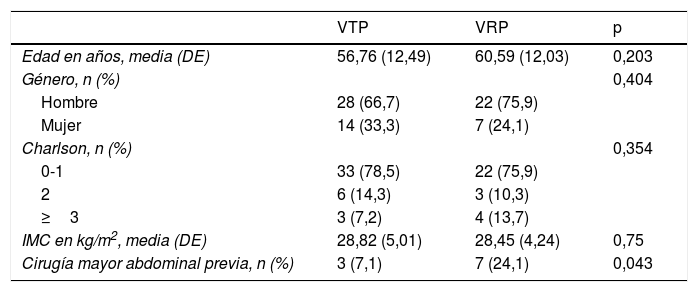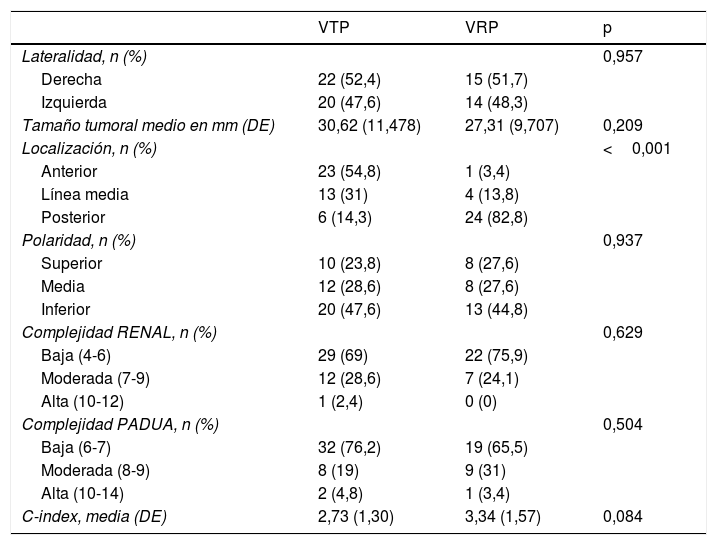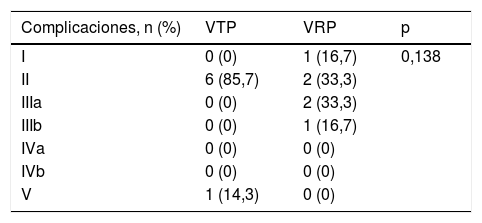La nefrectomía parcial laparoscópica es el tratamiento recomendado en aquellos tumores con un tamaño inferior a 4cm en los cuales sea factible. Dependiendo de la localización del tumor se considerará la vía transperitoneal (VTP) o la vía retroperitoneal directa(VRP).
ObjetivoComparar las nefrectomías parciales VTP y VRP realizadas entre 2007-2016.
Material y métodosEstudio retrospectivo de 71 pacientes sometidos a VTP (42) y VRP (29). Se han evaluado características propias de los pacientes y del tumor, incluyendo la complejidad tumoral (PADUA, RENAL,C-index). Se compararon variables perioperatorias, incluyendo las complicaciones, entre ambas vías.
ResultadosNo encontramos diferencias en cuanto a edad, género, Charlson o IMC. Encontramos una mayor proporción de pacientes con cirugía mayor abdominal previa en la VRP (7,1 vs. 24,1%; p=0,043). No hallamos diferencias en el tamaño, en la lateralidad ni la polaridad, ni en la complejidad de los tumores en ninguno de los scores evaluados. Encontramos diferencias significativas en la localización del tumor (anterior/medio/posterior) entre la VTP y la VRP (54,8/31/14,3 vs. 3,4/13,8/82,8%; p<0,001). No encontramos diferencias en el tiempo quirúrgico ni en los días de estancia. La VTP presentó una menor apertura de la vía urinaria (4,8 vs. 27,6%; p=0,007) y un mayor porcentaje de pacientes con renorrafia hemostática (47,6 vs. 17,2%; p=0,008). No se encontró diferencia en la necesidad de isquemia caliente, en los cambios en la hemoglobina ni en el filtrado glomerular. La tasa de complicaciones es similar entre ambas series.
ConclusiónAmbas vías muestran resultados similares en cuanto a la preservación de la función renal, las complicaciones y los resultados oncológicos. A pesar de ello, consideramos que es recomendable conocer ambas técnicas y adaptar el tipo de acceso al caso clínico.
Laparoscopic partial nephrectomy is the recommended treatment for tumours smaller than 4cm in cases where it is feasible. Depending on the location of the tumour, the transabdominal or direct retroperitoneal pathway may be considered.
ObjectiveTo compare the transperitoneal (TPPN) and direct retroperitoneal (RPPN) partial nephrectomies performed between 2007 and 2016.
Material and methodsA retrospective study was conducted on 71 patients who underwent TPPN (42) or direct RPPN (29) partial nephrectomy. We evaluated the characteristics of the patients and tumours, including tumour complexity (PADUA, RENAL, C-index). We compared perioperational variables, including the complications between the 2 pathways.
ResultsWe found no differences in terms of age, sex, Charlson's score and BMI. A larger proportion of patients in the direct RPPN group had prior major abdominal surgery (7.1 vs. 24.1%; P=.043). There were no differences in tumour size, laterality, polarity or complexity in any of the assessed scores. There were significant differences in tumour location (anterior/middle/posterior) between the TPPN and RPPN groups (54.8/31/14.3 vs. 3.4/13.8/82.8%; P<.001). There were no differences in the surgical time or length of stay. The TPPN group had a smaller urinary tract opening (4.8 vs. 27.6%; P=.007) and a higher percentage of haemostatic renorrhaphy (47.6 vs. 17.2%; P=.008). There were no differences in the need for warm ischaemia, in the changes in haemoglobin levels or in the glomerular filtration rate. The complication rates were similar for the two series.
ConclusionThe two pathways show similar results in terms of renal function preservation, complications and oncological results. However, we recommend understanding both techniques and adapting the access type to the clinical case.















